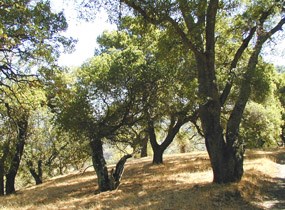
Redwood forests are dark and quiet places found from Monterey County to Southern Oregon. One of the few patches in Golden Gate that survived the gold rush and the rise of San Francisco Bay as a metropolitan area is at Muir Woods. There are also redwoods in the Phleger Estates in San Mateo county. Two trees are characteristically associated with coast redwood, tanbark oak and California bay laurel. Redwoods need moist areas in valleys or near springs to support their legendary height. In the understory shrubs such as hazelnut, thimbleberry, western azalea and wood rose are common. Wild ginger, trilium, redwood sorrel, sweet coltsfoot, elk clover, and sword ferns give ground cover and wildflowers. Wildlife may seem rare or absent entirely. Many forest creatures live high in the forest canopy (such as the grey squirrel and Sonomoa chipmunk) or deep in leaf litter on the forest floor such as the California giant salamander, slender salamander, and rough-skinned newt. Raccoons and grey foxes seek shelter in hollows in trees and logs. Deep wooded canyons are specialized habitat. There are few insects, repelled by the tannins in Redwood bark, and the deep shade limits the number of flowers and fruit produced. Few food sources mean few bird species, although the old growth forest does support the endangered spotted owl. 
NPS Photo Oak woodlands are named after the Coast live oak. Live oaks occur in small stands mixed in with grasslands throughout the park. The understory is well-lit with a few shrubs and a wide variety of herbaceous plants. Very abundant in coastal regions, it is due to the acorns of this and the tanbark oak that native Americans of coastal California were able to subsist without agriculture. Live oaks are also known as attracting high insect diversity, and thus birds such as gleaners (insectivores), jays (which cache the nuts), and woodpeckers as well. They also provide cover and shade in what is otherwise extremely exposed habitat. Traveling mammals such as bobcats and coyotes will stop over for a rest. Sometimes buckeyes of bay trees are mixed in with the live oaks. Understory shrubs include buck brush, coffee berry, toyon, poison oak, and snow berry. Ferns such as gold back ferns and polypody ferns are also found under the shade of their branches. The endangered San Mateo wooly sunflower is a late spring, short-lived herbaceous perennial whose golden flowers can be seen in clearings of live oak woodlands in the Crystal Springs area of San Mateo County. |
Last updated: October 11, 2024
